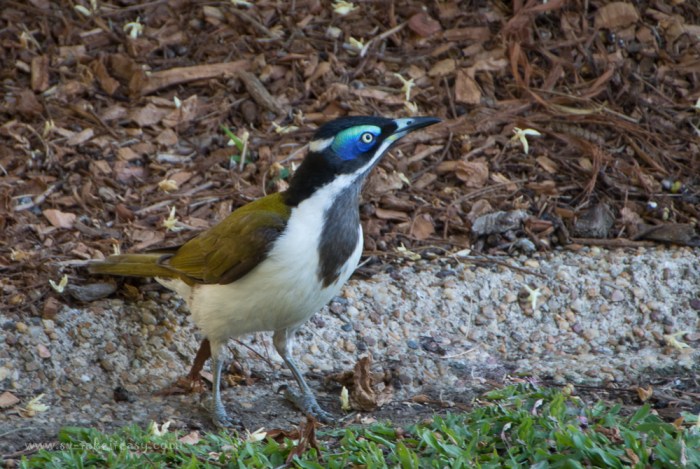Our interest was struck by this unmistakable honeyeater with its brilliant blue facial skin, and its varied song that starts early in the morning before many other birds. Our first sighting of the Blue-Faced Honeyeater (Entomyzon cyanotis) was during our winter cruise in Queensland and it makes a handsome subject for our #31 Bird Photography Challenge.
What does it look like?
 The Blue-Faced Honeyeater, just as its name suggests, is a large honeyeater with striking two-toned blue skin around the pale yellow eyes, the lower half being a brilliant cobalt blue. About 26 to 32 cms long, and with a wingspan of about 44 cms, it is a large honeyeater. The plumage is olive green on its upperparts and wings, white on the underparts, and the flight feathers are brown. The head is black, and the throat and upper breast are grey-black. A narrow white stripe crosses the nape, and another white stripe starts from lower base of the bill, which is pale blue with a dark grey tip. The feet and legs are blue-grey. So all in all, this is a handsome, easily recognizable bird.
The Blue-Faced Honeyeater, just as its name suggests, is a large honeyeater with striking two-toned blue skin around the pale yellow eyes, the lower half being a brilliant cobalt blue. About 26 to 32 cms long, and with a wingspan of about 44 cms, it is a large honeyeater. The plumage is olive green on its upperparts and wings, white on the underparts, and the flight feathers are brown. The head is black, and the throat and upper breast are grey-black. A narrow white stripe crosses the nape, and another white stripe starts from lower base of the bill, which is pale blue with a dark grey tip. The feet and legs are blue-grey. So all in all, this is a handsome, easily recognizable bird.
How does it behave?
There is nothing discreet about this noisy and gregarious bird. It is usually seen in pairs or small flocks of up to seven birds and tends to muscle in on other bird species while feeding. The Blue-faced Honeyeater mostly feeds on insects and other invertebrates, but also eats nectar and fruit from native and exotic plants. It forages on the bark and limbs of trees, as well as on flowers and foliage.
The Blue-Faced Honeyeater rarely builds a nest. Rather it uses the abandoned nests of noisy miners, wattlebirds or friarbirds, refining these and adding to them. Both the male and female tend to the young.
Did you know?
In Queensland, it feeds on the flowers and fruit of the banana trees, which explains its colloquial name: the banana-bird. It can strongly damage ripe fruit, so in orchards, it is often considered a pest.
Where is it found?
Widespread in the Northern and Eastern parts of Australia, it is often seen in orchards, farmlands, open forest, coastal heathlands and even in suburban parks. We saw several in the parkland adjoining the marina in Tin Can Bay and in Yeppoon, where their raucous calls attracted our attention. Being photogenic and not easily scared, photographing them at close range was relatively easy. All images were taken with a Canon 7Dii and Tamron 18-270 lens.
Click on any image in the gallery to display in full screen.











Very pretty, you have such different birds in Australia than New Zealand!
I am sure we’d find the same if we came over to NZ! This one we had never seen before until we sailed North. Quite striking isn’t it!
Great honeyeaters Chris. Very noisy and beautiful. Seen lots in the NT.
We don’t have them in Vic so they were quite a find for us!
Beautiful captures – I’ve long admired this bird! 🙂
The blue around the eyes is striking and the song is hard to ignore!
I love the blue!! He’s lovely!!
Hi Cybele, I agree, the graduation is the blue and its intensity are really striking.